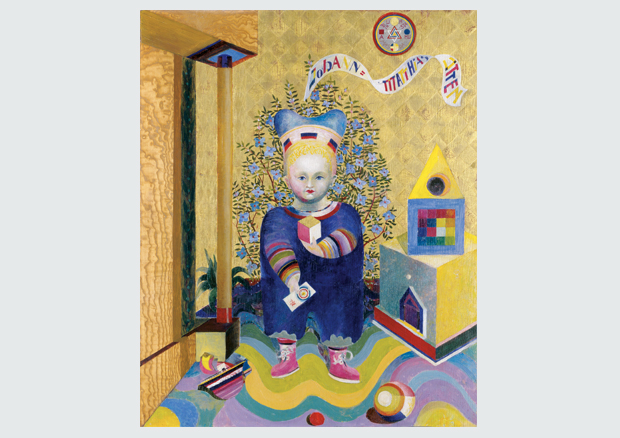Johannes Itten: Art as Life. Bauhaus Utopias and Documents of Reality
In the Bauhaus anniversary year of 2019, the Kunstmuseum Bern is devoting an exhibition to the major Swiss artist and Bauhaus Master Johannes Itten (1888-1967), which will for the first time focus on Itten’s utopian project of holistically merging life and art.
Like very few other artists, Johannes Itten saw art and life as being closely connected; personal experiences and philosophical reflections are apparent in his work in many different ways. The central pieces in the exhibition are Itten’s diaries and sketchbooks, recently researched and never previously exhibited on this scale, which accompanied his artistic practice from 1913.
In the context of key works from his painterly oeuvre with numerous pages from his diaries the exhibition sheds new light on Itten’s previously unknown form of disclosing the world through drawing, and the artistic working processes that emerged from it. Central to this are Itten’s diaries – newly researched and never previously shown on this scale – which are also his sketchbooks, and which, as blocks several hundred pages long, are being shown in their entire thematic range: they reveal not only Itten’s pioneering art-theoretical reflections, on colour theory amongst other things, but also his thoughts on an elementary theory of art, his studies of Old Masters, but also traces of his reading of the esoteric and scientific ideas of his time.
«Using the example of Johannes Itten the exhibition places several established art-historical narratives of modern art under examination: more consistently than many others, Johannes Itten was a very early adopter of the conceptual concept of art and the ideas of the alternative ‹Lebensreform› movement with regard to the connection between art and life. His sketchbooks show an artist in a constant process of exploration, of artistic reflection, of alternation between abstraction and figurative representation. At the same time Itten propagated his ideal, half a century before Joseph Beuys, that ‹everyone is creatively gifted›.»
Christoph Wagner, Institute of Art History, Regensburg University
These ideas are connected with his notes on everyday life, precise records and sketches: before the birth of his son, for example, whom he documented as an artist and a father. Ideas of vegetarian food, breathing doctrine, rhythmic gymnastics and other contemporary elements of an alternative transformation of life in the first centuries of the 20th century are present here.
Also inseparably connected with his vision of art, however, are art-historical ideas of development, which reveal distinctly racial features, particularly in his lectures – and this is borne out by lecture manuscripts from the 1920s, also shown here. In formulations about the ‹white race, which God recognised in himself›, disconcerting to us today, they grant an insight into elitist thought-structures which were widespread in European avant-garde circles. Here itten shows himself, amongst other things, to be inspired by theosophical visions of the world and the ideas of evolution contained in Mazdaznan teachings, which enjoyed a boom as a result of contact with other global civilisations during the period of colonialism in the early 20th century.
«Itten’s radically innovative artistic and pedagogical work is one of the most important Swiss contributions to modern culture and art education in the 20th century. At the same time, like many European intellectuals of his time – Rudolf Steiner is of central importance here – he identified with racist philosophies of civilisation. The exhibition shows Itten comprehensively and in all of his facets, using extensive documentary material, lecture manuscripts and diaries never previously exhibited, and thus provides an opportunity to have a nuanced image of Itten’s personality as an artist.»
Nina Zimmer, Director, Kunstmuseum Bern – Zentrum Paul Klee
The exhibition, organised as a journey through the stages of Johannes Itten’s life from 1913 until 1938, allows us to discover new facets of the artist and his diverse body of work. The exhibition traces Itten’s development from his beginnings in Switzerland, via the stages of his life in Stuttgart, Vienna, Weimar and Herrliberg, also taking in his commitments in Berlin, Krefeld and Amsterdam before, having been branded as a ‹degenerate› artist in Germany, he returned to Switzerland.
An exhibition by the Kunstmuseum Bern. It will subsequently (08.03. – 28.06.2020) be shown in the Kunstforum Hermann Stenner in Bielefeld.
Curators
Nina Zimmer, Director, Kunstmuseum Bern – Zentrum Paul Klee
Christoph Wagner, Institute of Art History, Regensburg University
With the support of
The Canton of Bern, Credit Suisse, Museumsstiftung für Kunst der Burgergemeinde Bern, UNIQA Kunstversicherung Schweiz, Ursula Wirz-Stiftung, Ruth & Arthur Scherbarth Stiftung, die Mobiliar, GVB Kulturstiftung
On the occasion of the Bauhaus‘100th anniversary, Bern will become the Bauhaus centre of Switzerland and celebrate its masters
«bauhaus imaginista» in the Zentrum Paul Klee
In parallel, the Zentrum Paul Klee is showing the exhibition «bauhaus imaginista» from 20.09.2019 until 12.01.2020.
Exhibition information
Between 8 August and 22 November 2020 the exhibition «Johannes Itten und Thun: Transformationen der Natur» will be held in the Kunstmuseum Thun.
Contact
Maria-Teresa Cano
Head of Communication and Public Relations Kunstmuseum Bern – Zentrum Paul Klee , Tel.: +41 31 328 09 44
To the press area
(Please log in to download the image material)


